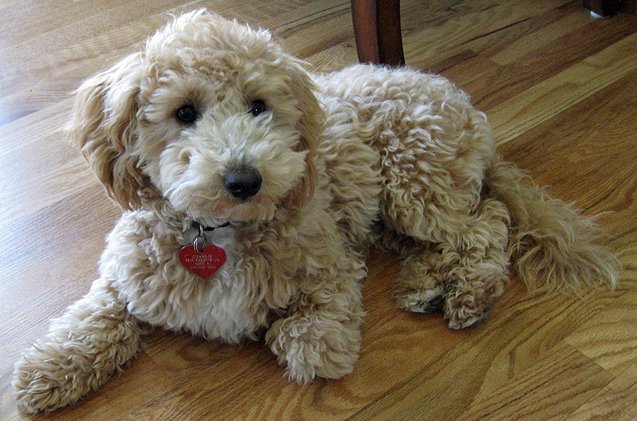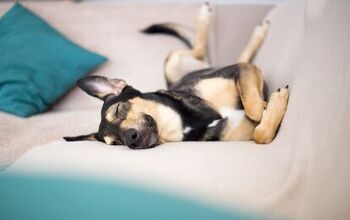Bichpoo


About Bichpoo
Bichpoo Basics
Sure, the name might be a bit questionable if you say it too quickly, but there’s no denying that the Bichpoo is one of the most delightful pups that you’ll ever meet. Fluffy, smart, and friendly, this lovely designer dog makes for a perfect family pet. Also known as a Poochon or Bichon Poodle, the Bichpoo is a mix between a Bichon Frise and a Toy (or Miniature) Poodle. He has a small but sturdy stature. He’s also highly intelligent and eager to please, which makes him easy to train (a highly underrated quality in any dog breed). Newbie dog owners should definitely consider this designer dog, as they’re very beginner-friendly breed. This is an ideal first dog to bring into any home and one guaranteed to make you a dog lover for life.
The Bichpoo is also quite adaptable when it comes to sharing his home with other animals, making it a perfect fit for families who already have pets. This pup will happily make friends with any furry member of your family. While the Bichpoo makes a great little watchdog, he can be prone to excessive barking so needs to be taught to downplay this trait when he is young and learning his socialization skills. Proper training will curb his yappy tendencies and ensure that this breed is suitable for apartment living. It’s important to train and socialize early to avoid your Bichpoo developing the dreaded “little dog syndrome.”
Designer dogs are still a mystery to many pet owners. They generally aren’t recognized by the AKC and it’s hard to get much of a sense of the history of most hybrid breeds. Purebred dogs remain more popular than designer dogs, but slowly that’s changing. Many new breeds offer a lot of impressive qualities in one adorable package. The Bichpoo is one of those breeds who stand out with their great personality and absolutely adorable appearance. So is the Bichpoo the dog that you’ve been hunting and needs to become part of your family? Read on to learn more about what makes these hybrids special and find out if you’ll be bringing one home soon.
Also known as a Poochon or Bichon Poodle, the Bichpoo is a mix between a Bichon Frise and a Toy (or Miniature) poodle.
Origin
Many designer dogs have something of a mysterious past – you can’t exactly pinpoint when and where the overwhelming majority of these hybrid breeds came to be. One of the reasons for this is that it’s difficult to discern when a certain crossbreed became a product of intentional breeding between two purebred dogs, and when, well, it was just a happy little “accident”. The Bichpoo might not have a more detailed past such as the Labradoodle or similar more popular designer dog breeds, but we can definitely say approximately what time and place this breed was originally developed.
The Bichpoo originated in Australia in the late 1990s and was bred specifically for families wanting a robust and active little dog with a non-shedding coat and a temperament that worked well with children. While this hybrid might not have a long history in comparison to his prestigious parents, he’s already proven to be a lovely dog with plenty of desirable traits. It didn’t take long before breeders in the United States and the United Kingdom started developing this hybrid. The popularity of the Bichpoo spread quickly and it soon became a mainstay of the designer dog world. Now there are many happy families that have a Bichon Frise and Poodle mix as their furbaby.
Pedigree
Bichpoos are hybrids that come from first generation cross-breeding between a purebred Bichon Frise and Toy (or Miniature) poodle. Like the majority of designer dogs, Bichpoos are also not uniform when it comes to their looks and behavior. The reason for this is that first generation mixes are the most unpredictable type of crossbreeds. Even in one litter, puppies can look completely different one from another. Some might favor the Bichon Frise in their appearance, while others could inherit more traits from the Poodle parent. Luckily, the parental breeds of this mix are somewhat similar, so there are no drastic differences within the breed. Bichpoo puppies tend to be fairly similar regardless of which parent they favour.
With multigenerational breeding, dogs start to have a standardized look, but there are other risks. Introducing other unrelated Bichons, Poodles, or Bichpoos to the gene pool can exacerbate certain health issues. The key is to find a reputable breeder. You’re looking for a breeder who selects his stock carefully and produces puppies responsibly. Dubious puppy mills or pet stores are never a good place to get a puppy, let alone a designer dog. These poor souls are often very mistreated and come with a host of health issues. It truly is tragic what can happen at these places.
It’s important to note that even when you are getting a puppy from a reputable breeder, you can’t expect them to have official pedigree documentation like a purebre puppy would. The reason for this is that designer dogs are not officially recognized by the AKC or any other major canine organizations – in their eyes, the Bichpoo is a cute mixed breed dog, but not a breed in its own right. One of the reasons for this is the lack of uniformity or “breed standard”, as you can never really predict how a Bichpoo will look like, and with established purebred dogs, you can have realistic expectations about everything from coat colors to height and weight.
However, you may ask the breeder to show you pedigree papers of the parents to get a better insight into your puppy’s lineage and some possible traits they could inherit. Similarly, some even offer unofficial papers from smaller dog organizations dedicated to designer dog breeds which are working towards creating a standard for each designer dog and elevating their status overall.
Food/Diet
As a small dog with high energy, you should feed your Bichpoo frequent small meals of a top quality food throughout the day and because of the propensity for small dogs to have dental problems, dry food and treats should become a mainstay of his diet. By providing a high-quality food that contains all-natural, quality ingredients you will help prevent him from picking up allergies – a health concern known to plague Bichons and Poodles. A reputable pet store will typically carry a good selection of higher quality products. By higher quality, we mean formulas that are made with healthy ingredients, with real meat as the first ingredient on the list – ideally, it would be a single protein source, followed by healthy fats, complex carbohydrates, and a variety of vitamins, minerals, and trace nutrients your dog needs to thrive. In addition, the formula you pick should be tailored to the unique needs of your Bichpoo, which means dry food for small breed dogs of low to moderate activity levels, in the age group appropriate for your pet (puppy, adult, or senior).
If you have any concerns about your Bichpoo’s diet, it’s always a wise idea to consult with your vet. While pet food manufacturers and pet blog provide useful feeding guidelines, these are still guidelines and not gospel. Only a vet who is familiar with your specific dog can accurately assess the dietary needs of personal pooch. So, always check in with your vet before making any major changes to your dog’s diet.
With Poodle DNA running through his veins, you can bet your Bichpoo is going to be one intelligent little dog who will learn quickly and prove fairly easy to train.
Training
With Poodle DNA running through his veins, you can bet your Bichpoo is going to be one intelligent little dog who will learn quickly and prove fairly easy to train. As with any puppy, his behavioral and socialization training must be done at an early age and because Poodles can sometimes take on high-strung and clingy characteristics, so you’ll want to work on this from the beginning. Understandably many small dogs are known to revert to nipping if they feel threatened or anxious, so working with a professional trainer to discourage this tendency and develop a game-plan to eliminate separation anxiety issues, would be money well spent. As with any pet training, it’s important to focus on positive reinforcement and treat-based encouragement. Anything less is closer to abuse than training. It will not get you the results that you seek from your pup.
Weight
The weight of a Bichpoo is typically influenced by whether the poodle side of his parentage is a Toy or Miniature. If Toy, the Bichpoo will reach a weight of between 6-12 pounds. If a Miniature, you can expect his weight to range up to 18 pounds. Generally, the Bichpoo fits easily into the true small size dog breed. As such, they don’t need too much space to be content and can do perfectly well as apartment pets, as long as you provide them with plenty of space outside to exercise and spend their energy. These are lively and energetic dogs, so it won’t do them good if you leave them cooped up for long. Luckily, Bichpoos are not easy to become obese. This can happen if you neglect your pet and its diet, and particularly if it’s a smaller type. However, a properly cared for Bichpoo that spends enough energy and has a lot of activities during the day, will be as lean and well-built as any other healthy dog breed.
Temperament/Behavior
Sweet and loving, Bichpoo dogs make fantastic family pets precisely because of their great personality. When socialized properly, these designer dogs are bubbly and outgoing, happy to be around people, and quite affectionate with everyone they meet – but above all, with their humans. They will quickly grow on anyone that meets them! If you want a cuddly, kind dog that will love nothing more than to be petted and curl up with you when you watch the TV or lie down on the sofa after a long day, Bichpoo is your pooch.
Thanks to their parentage, these smart cookies are natural-born charmers, goofy clowns that bring joy to your everyday life with their antics. They are quite playful and intelligent, so they’ll enjoy (and require) a lot of playtime, particularly with puzzle toys. And don’t forget fetch or tug of wars – everything Bichpoos can do with their owner is something they love doing!
A common behavioral issue some Bichpoos might develop is excessive barking. This is common with Bichons, and might be passed down the line to the Bichpoo. These dogs have a tendency to bark a lot, mostly in order to get their master’s attention, warn of possible intruders, or simply to warn anyone wishing to take away their food or toys. Some say that even though the Bichpoo is a designer breed, it can still make a good watch dog due to its tendency to warn the owner about strangers. Still, if the Bichpoo is not socialized enough at a young age, the barking might become unbearable later on. Thankfully, it can be remedied with some patient training. Of course, it helps to properly socialize and train your pet at an early age and to avoid this issue altogether.
Common Health Problems
The plus to a first generation hybrid is that many of the serious health issues that plague the parent breeds can often by-pass their offspring. Unfortunately, that can never be assumed and new pet parents should be aware of potentially inherited issues. For the Bichpoo that can include progressive retinal atrophy, patella luxation and allergies. And while not an inherited but a health and wellness issue that is typical of all small dogs, the Bichpoo can be prone to breaks and fractures if dropped from any height. Supervision is recommended whenever young kids are involved in playtime. This is why it’s important to maintain regularly schedule checkups with your vet, especially as they age. It’s important that any potential health issues be identified and treated as early as possible.
A somewhat uncommon but still possible health issue amongst Bichpoos is the pesky hip dysplasia. It affects a lot of dog breeds of this size, and is an inherited issue. It is a multifactorial orthopedic condition that affects the dog’s hip joint. If left untreated, hip dysplasia can lead to major changes in the hip joint, causing osteoarthritis and major pain and discomfort. Although this is a rare occurrence, it is still worth mentioning. Luckily, it can be helped with the assistance of your vet.
Life Expectancy
The average life span of a Bichpoo is 12-15 years. With 15 years being at the high end of the life expectancy amongst dogs, this means that Bichpoo is a hardy and long lived breed. Of course, this is only achievable with good genetics, plenty of care, and a loving environment. A neglected dog is unlikely to ever reach this age. Best of all, such a generous lifespan makes Bichpoos ideal as companion dogs. If you dreamed of having a furry, four legged companion to be by your side for a good part of your life, then consider a Bichpoo as a great choice.
Exercise Requirements
The Bichpoo has loads of energy and loves to play for what may seem like endless periods of time to his owners. Because of his tendency towards energy bursts, he needs daily walks of at least one-half hour and regular playtime that will keep him physically active and mentally stimulated. This is particularly important to keep in mind for apartment dwellers that are unable to let him out for a quick run in the yard. Failure to keep your Bichpoo active and engaged may result in a dog that becomes quickly bored, restless and begins to whine, bark, and chew. Nobody wants a dog like that in their home, so regular exercise is of vital importance to avoid any of these problem behaviours rearing their ugly heads.
The Bichpoo typically exhibits many of the same characteristics as his Bichon Frise and Toy poodle parents, including a lively, intelligent and affectionate disposition.
AKC
Because he is a hybrid breed, the Bichpoo is not a member of the American Kennel Club however there are many smaller organizations that recognize this mix as a breed. The American Canine Hybrid Club, Designer Dogs Kennel Club, Designer Breed Registry and International Designer Canine Registry all recognize the Bichon Frise and Poodle mix under the name Poochon. The Dog Registry of America, Inc. recognizes is it under all common names.
Coat
The Bichpoo’s coat is typically soft and curly and Poodle lineage means they are light shedders and hypoallergenic. Typically his coat is light (either white or apricot colored) and it will require daily brushing to keep it looking its best (and to prevent any unfortunate matting). A visit to the groomer for clipping should take place every six to eight weeks to prevent matting and keep his coat short and easy to care for.
Puppies
The litter size of Bichpoo puppies can depend on the type of Poodle used in the mix. However, since Bichon Frise dog is commonly the mom of the litter, you can usually expect to see between 2 and 5 puppies. These adorable little mixes will steal your heart with their goofy behavior and cute looks, but it’s important to make sure to be careful around them. As the offspring of two small breed dogs, Bichpoo puppies are very fragile and prone to injuries, especially in their puppyhood. Don’t leave them to play with children without supervision and monitor they don’t jump on and off high surfaces. You must take special care of Bichpoos as puppies because they are so delicate and fragile. However, this sort of love and care should only deepen the bond between this pup and his human, so it will pay off quite a bit in the long run.
Naturally, it goes without saying that puppyhood is the perfect period to start training and socialization – the earlier you start, the better. Usually, simple training can start around two months of age, and slowly progresses to more complex tasks, for instance potty training, which is usually done between 12 and 16 weeks of age. As for socialization, it’s important to give your puppy the chance to grow accustomed to different pets, strangers, children, and so on – so they wouldn't have issues with people or animals outside the family as they reach adulthood. Just remember that they are fragile while you socialize them and avoid rowdy small kids that oculd inadvertently hurt them or larger, more energetic dogs (for the same reason).
Photo credit: CharliesMom12/Flickr; mikeledray/Bigstock; VladimirNenezic/Bigstock

Sharing space with three seriously judgy Schnoodles and a feline who prefers to be left alone. #LivingMyBestLife
More by Mary Simpson
























